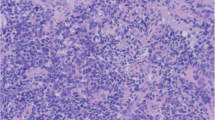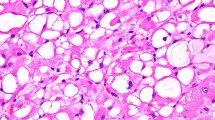Abstract
Rhabdomyosarcoma presents special diagnostic problems when it involves the uterine cervix in young children because tumor cells may lack marked atypia and may blend with the normal, immature, condensed, cellular stroma, rendering diagnosis difficult. Myogenic makers are a valuable ancillary technique for establishing a diagnosis of rhabdomyosarcoma. However, desmin positivity has been reported in cervical stromal cells, which can confound diagnosis. To determine whether immunohistochemical markers of skeletal muscle differentiation are helpful in the diagnosis of uterine botryoid rhabdomyosarcoma, we compared the immunohistochemical staining pattern of cervical rhabdomyosarcoma from 3 patients with that of normal uteri from age-matched autopsy controls by using antibodies for desmin, smooth muscle actin, muscle-specific actin, myoD1, myogenin, and WT-1. All tumors demonstrated at least focal immunopositivity for desmin, muscle-specific actin, smooth muscle actin, myoD1, and WT-1, and 1 tumor was also positive for myogenin. Autopsy controls showed only scattered subepithelial stromal immunoreactivity for desmin, muscle-specific actin, smooth muscle actin, and WT-1 and showed cytoplasmic, but not nuclear, immunopositivity for myoD1 and myogenin. Myometrium was diffusely positive for desmin and muscle-specific actin. We conclude that desmin, muscle-specific actin, smooth muscle actin, and WT1 are not specific for discriminating embryonal rhabdomyosarcoma from normal subepithelial cells in the female genital tract of children, although the number of immunopositive cells is consistently larger in rhabdomyosarcoma. Nuclear staining for myoD1 and myogenin appears not to occur in normal tissue, but it may be absent or sparse in embryonal rhabdomyosarcoma. Our findings indicate that, in this anatomic site, the diagnosis of rhabdomyosarcoma and in particular determination of tumor margins remain very reliant on histomorphology.

Similar content being viewed by others
References
Coffin CM, Dehner LP. The soft tissues. In: Stocker JT, Dehner LP, eds. Pediatric Pathology. Philadelphia: Lippincott Williams & Wilkins, 2001;1186
Willis RA. The female genitalia. In: Willis RA, ed. The Borderland of Embryology and Pathology. Washington: Butterworths, 1962;98–102
O’Shea PA. Myogenic tumors of soft tissue. In: Coffin CM, Dehner LP, O’Shea PA, eds. Pediatric Soft Tissue Tumors: A Clinical, Pathological, and Therapeutic Approach. Baltimore: Williams & Wilkins, 1997;214–253
Sebire NJ, Malone M. Myogenin and MyoD1 expression in paediatric rhabdomyosarcomas. J Clin Pathol 2003;56:412–416
Pediatric Oncology Resource Center. Available at: http://www.acor.org/ped-onc/diseases/rhabdo.html. Accessed January 20, 2005
Dehner LP. Female reproductive system. In: Dehner LP, ed. Pediatric Surgical Pathology. Baltimore: Williams & Wilkins, 1987;752–753
Hardaway CA, Graham BS, Barnette DJ, Feldman BD. Embryonal rhabdomyosarcoma presenting in an adult: a case report and discussion of immunohistochemical staining. Am J Dermatopathol 2003;25:45–52
Lai R, Tian Y, An J, Zhou MW, Zou G, Li W. A comparative study on morphology and immunohistochemistry of rhabdomyosarcoma and embryonal skeletal muscles. Chin Med J (Engl) 1997;110:392–396
Cui S, Hano H, Harada T, Takai S, Masui F, Ushigome S. Evaluation of new monoclonal anti-MyoD1 and anti-myogenin antibodies for the diagnosis of rhabdomyosarcoma. Pathol Int 1999;49:62–68
Kumar S, Perlman E, Harris CA, Raffeld M, Tsokos M. Myogenin is a specific marker for rhabdomyosarcoma: an immunohistochemical study in paraffin-embedded tissues. Mod Pathol 2000;13:988–993
Weintraub H, Davis R, Tapscott S, Thayer M, Krause M, Benezra R, Blackwell TK, Turner D, Rupp R, Hollenberg S, et al. The myoD gene family: nodal point during specification of the muscle cell lineage. Science 1991;251:761–766
Venuti JM, Morris JH, Vivian JL, Olson EN, Klein WH. Myogenin is required for late but not early aspects of myogenesis during mouse development. J Cell Biol 1995;128:563–576
Davis RL, Weintraub H, Lassar AB. Expression of a single transfected cDNA converts fibroblasts to myoblasts. Cell 1987;51:987–1000
Tapscott SJ, Davis RL, Thayer MJ, Cheng PF, Weintraub H, Lassar AB. MyoD1: a nuclear phosphoprotein requiring a Myc homology region to convert fibroblasts to myoblasts. Science 1988;242:405–411
Rudnicki MA, Jaenisch R. The MyoD family of transcription factors and skeletal myogenesis. Bioessays 1995;17:203–209
Dias P, Parham DM, Shapiro DN, Tapscott SJ, Houghton PJ. Monoclonal antibodies to the myogenic regulatory protein MyoD1: epitope mapping and diagnostic utility. Cancer Res 1992;52:6431–6439
Folpe AL. MyoD1 and myogenin expression in human neoplasia: a review and update. Adv Anat Pathol 2002;9:198–203
Cessna MH, Zhou H, Perkins SL, Tripp SR, Layfield L, Daines C, Coffin CM. Are myogenin and myoD1 expression specific for rhabdomyosarcoma? A study of 150 cases, with emphasis on spindle cell mimics. Am J Surg Pathol 2001;25:1150–1157
Wang NP, Marx J, McNutt MA, Rutledge JC, Gown AM. Expression of myogenic regulatory proteins (myogenin and MyoD1) in small blue round cell tumors of childhood. Am J Pathol 1995;147:1799–1810
Furlong MA, Mentzel T, Fanburg-Smith JC. Pleomorphic rhabdomyosarcoma in adults: a clinicopathologic study of 38 cases with emphasis on morphologic variants and recent skeletal muscle-specific markers. Mod Pathol 2001;14:595–603
Wang NP, Bacchi CE, Jiang JJ, McNutt MA, Gown AM. Does alveolar soft-part sarcoma exhibit skeletal muscle differentiation? An immunocytochemical and biochemical study of myogenic regulatory protein expression. Mod Pathol 1996;9:496–506
Carpentieri DF, Nichols K, Chou PM, Matthews M, Pawel B, Huff D. The expression of WT1 in the differentiation of rhabdomyosarcoma from other pediatric small round blue cell tumors. Mod Pathol 2002;15:1080–1086
Sredni ST, Soares FA, de Caballero OL, de Camargo B. The expression of WT1 in the differentiation of rhabdomyosarcoma from other pediatric small round blue cell tumors [letter]. Mod Pathol 2002;15:1080–1086
Acknowledgment
The authors thank James A. Edwards, BS, HT (ASCP), QIHC, Tonora Archibald, HT (ASCP), QIHC, and Cathy Quigley, FIBMS, HTL (ASCP), for assistance with the immunohistochemical staining.
Author information
Authors and Affiliations
Corresponding author
Additional information
An erratum to this article is available at http://dx.doi.org/10.1007/s10024-005-8000-y.
Rights and permissions
About this article
Cite this article
Riedlinger, W.F.J., Kozakewich, H.P.W. & Vargas, S.O. Myogenic Markers in the Evaluation of Embryonal Botryoid Rhabdomyosarcoma of the Female Genital Tract. Pediatr Dev Pathol 8, 427–434 (2005). https://doi.org/10.1007/s10024-005-0006-y
Received:
Accepted:
Published:
Issue Date:
DOI: https://doi.org/10.1007/s10024-005-0006-y




